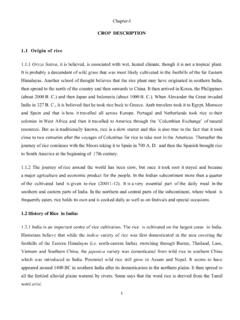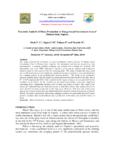Transcription of Maize Production Technologies in India - …
1 Maize Production Technologies in India 1. Introduction Maize (Zea mays L) is one of the most versatile emerging crops having wider adaptability under varied agro-climatic conditions. Globally, Maize is known as queen of cereals because it has the highest genetic yield potential among the cereals. It is cultivated on nearly 150 m ha in about 160 countries having wider diversity of soil, climate, biodiversity and management practices that contributes 36 % (782 m t) in the global grain Production . The United States of America (USA) is the largest producer of Maize contributes nearly 35 % of the total Production in the world and Maize is the driver of the US economy. The USA has the highest productivity (> t ha-1) which is double than the global average ( t ha-1). Whereas, the average productivity in India is t ha-1. In India , Maize is the third most important food crops after rice and wheat.
2 According to advance estimate it is cultivated in m ha (2010-11) mainly during Kharif season which covers 80% area. Maize in India , contributes nearly 9 % in the national food basket and more than Rs. 100 billion to the agricultural GDP at current prices apart from the generating employment to over 100 million man-days at the farm and downstream agricultural and industrial sectors. In addition to staple food for human being and quality feed for animals, Maize serves as a basic raw material as an ingredient to thousands of industrial products that includes starch, oil, protein, alcoholic beverages, food sweeteners, pharmaceutical, cosmetic, film, textile, gum, package and paper industries etc. Recent trends (2003-04 to 2008-09) in growth rate of area ( %), Production ( %) and productivity ( %) of Maize in India has been of high order and experienced highest growth rate among the food crops.
3 Since 1950-51, the area, Production and productivity of Maize have increased by more than , 12 and times from m ha, m t and 547 kg ha-1 to current level of m ha, m t and 2414 kg ha-1, respectively due to increasing Maize demand for diversified uses. In India , the Maize is used as human food (23%), poultry feed (51 %), animal feed (12 %), industrial (starch) products (12%), beverages and seed (1 % each). With the increasing trends of Maize Production , the projected demand of Maize ( m t) by the end of XIth five year plan (2011-12) will be achieved through improved Maize Production Technologies focused on Single Cross Hybrids . 2 Feed61%Industrial22%Staple food17%GlobalPoultry feed51%Food23%Cattle feed12%Starch12%Brewery1%Seed1%India3 Current Maize utilization pattern The Maize is cultivated throughout the year in all states of the country for various purposes including grain, fodder, green cobs, sweet corn, baby corn, pop corn in peri-urban areas.
4 The predominant Maize growing states that contributes more than 80 % of the total Maize Production are Andhra Pradesh ( %), Karnataka ( %), Rajasthan ( %), Maharashtra ( %), Bihar ( %), Uttar Pradesh ( %), Madhya Pradesh ( %), Himachal Pradesh ( %). Apart from these states Maize is also grown in Jammu and Kashmir and North-Eastern states. Hence, the Maize has emerged as important crop in the non-traditional regions peninsular India as the state like Andhra Pradesh which ranks 5th in area ( m ha) has recorded the highest Production ( m t) and productivity ( t ha-1) in the country although the productivity in some of the districts of Andhra Pradesh is more or equal to the USA. 2. Soils Maize can be grown successfully in variety of soils ranging from loamy sand to clay loam. However, soils with good organic matter content having high water holding capacity with neutral pH are considered good for higher productivity.
5 Being a sensitive crop to moisture stress particularly excess soil moisture and salinity stresses; it is desirable to avoid low lying fields having poor drainage and also the field having higher salinity. Therefore, the fields having provision of proper drainage should be selected for cultivation of Maize . 3. Time of sowing Maize can be grown in all seasons viz; Kharif (monsoon), post monsoon, Rabi (winter) and spring. During Rabi and spring seasons to achieve higher yield at farmer s field assured irrigation facilities are required. During Kharif season it is desirable to complete the sowing operation 12-15 days before the onset of monsoon. However, in rainfed areas, the sowing time should be coincided with onset of monsoon. The optimum time of sowing are given below. Season Optimum time of sowing Kharif Last week of June to first fortnight July Rabi Last week of October for inter cropping and up to 15th of November for sole crop Spring First week of February 4.
6 Seed rate and plant geometry To achieve higher productivity and resource-use efficiencies optimum plant stand is the key factor. The seed rate varies depending on purpose, seed size, plant type, season, sowing methods etc. The following crop geometry and seed rate should be adopted. S. No. Purpose Seed rate (kg ha-1) Plant geometry (plant x row, cm) Plant population 1 Grain (normal and QPM) 20 60 x 20 75 x 20 83333 66666 2 Sweet corn 8 75 x 25 75 x 30 53333 44444 3 Baby corn 25 60 x 20 60 x 15 83333 111111 4 Pop corn 12 60 x 20 83333 4 5 Green cob (normal Maize ) 20 75 x 20 60 x 20 66666 83333 6 Fodder 50 30 x 10 333333 5. Seed treatment To protect the Maize crop from seed and major soil borne diseases and insect-pests, seed treatment with fungicides and insecticides before sowing is advisable/ recommended as per the below given details. Disease/insect-pest Fungicide/Pesticide Rate of application (g kg-1 seed) Turcicum Leaf Blight,, Banded Leaf and Sheath Blight, Maydis Leaf Blight Bavistin + Captan in 1:1 ratio BSMD Apran 35 SD Pythium Stalk Rot Captan Termite and shoot fly Imidachlorpit 6.
7 Tillage and crop establishment Tillage and crop establishment is the key for achieving the optimum plant stand that is the main driver of the crop yield. Though the crop establishment is a series of events (seeding, germination, emergence and final establishment) that depends on interactions of seed, seedling depth, soil moisture, method of sowing, machinery etc but, the method of planting plays a vital role for better establishment of crop under a set of growing situation. Maize is mainly sown directly through seed by using different methods of tillage & establishment but during winters where fields are not remain vacant in time (till November), transplanting can be done successfully by raising the nursery. However, the sowing method (establishment) mainly depends on several factors viz the complex interaction over time of seeding, soil, climate, biotic, machinery and management season, cropping system, etc.
8 Recently, resource conservation Technologies (RCTs) that include several practices viz. zero tillage, minimum tillage, surface seeding etc. had came in practice in various Maize based cropping system and these are cost effective and environment friendly. Therefore it is very important that different situations require different sowing methods for achieving higher yield as described below: (i) Raised bed (ridge) planting: Generally the raised bed planting is considered as best planting method for Maize during monsoon and winter seasons both under excess moisture as well as limited water availability/rainfed conditions. Sowing/planting should be done on the southern side of the east-west ridges/beds, which helps in good germination. Planting should be done at proper spacing. Preferably, the raised bed planter having inclined plate, cupping or roller type seed metering systems should be used for planting that facilitates in placement of seed and fertilizers at proper place in one operation that helps in getting good crop stand, higher productivity and resource use efficiency.
9 5 Using raised bed planting technology, 20-30 % irrigation water can be saved with higher productivity. Moreover, under temporary excess soil moisture/water logging due to heavy rains, the furrows will act as drainage channels and crop can be saved from excess soil moisture stress. For realizing the full potential of the bed planting technology, permanent beds are advisable wherein sowing can be done in a single pass without any preparatory tillage. Permanent beds are more beneficial under excess soil moisture situations as the infiltration rate is much higher and crop can be saved from the temporary water logging injury. (ii) Zero-till planting: Maize can be successfully grown without any primary tillage under no-till situation with less cost of cultivation, higher farm profitability and better resource use efficiency. Under such condition one should ensure good soil moisture at sowing and seed and fertilizers should be placed in band using zero-till seed-cum-fertilizer planter with furrow opener as per the soil texture and field conditions.
10 The technology is in place with large number of farmers particularly under rice- Maize and Maize -wheat systems in peninsular and eastern India . However, use of appropriate planter having suitable furrow opener and seed metering system is the key of success of the no-till technology. (iii) Conventional till flat planting: Under heavy weed infestation where chemical/herbicidal weed management is uneconomical in no-till and also for rainfed areas where survival of crop depends on conserved soil moisture, in such situations flat planting can be done using seed-cum-fertilizer planters. (iv) Furrow planting: To prevent evaporative losses of water during spring season from the soil under flat as well as raised bed planting is higher and hence crop suffers due to moisture stress. Under such situation/condition, it is always advisable to grow Maize in furrows for proper growth, seed setting and higher productivity.











